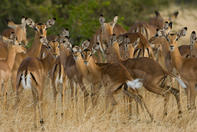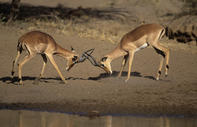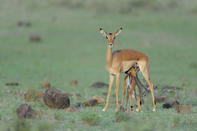Selfish Herds

Impala females and young live throughout the year in breeding herds. Males associate with breeding herds and outside the rutting season in bachelor groups.
This group association is known as ‘selfish herds’ as they provide safety in numbers, basically reducing any single individual’s chances of being the one that gets eaten! Impala, being the most common antelope in the Lowveld, have a host of predators including lion, leopard, cheetah, spotted hyena, jackal, caracal, pythons and even chacma baboons on occasion, the males catch the lambs.
The Rut Begins

One of the impala’s most successful tactics in remaining numerous is their breeding strategy. At the end of January, shorter day lengths trigger an increase in testosterone in the males and they separate out of their bachelor groups and begin the arduous task of setting up territories.
Ideally, these need to contain good food and access to water – the resources that will lure the females. Rams rush about chasing contenders away, tails extended and they issue fierce roars that might confuse first-time listeners into believing the source of the noise to be more than a mere impala! Females too are herded into the territory in this fashion.
More serious encounters between rams will involve horn clashes. The month of May is the peak of the rut and by this time, the males’ cavorting has induced the females to come into oestrus. This is a short-lived period for impala ewes. Within about a three week period all the females will be mated.
This has the knock-on effect that by Late November, early December, all the impala lambs in an area arrive within about a three week period. This flood of newborn impala provides a glut for predators but even they can’t eat all the lambs and a large proportion survives to bolster the impala population.
The intensity of the May rut is such that males are so busy herding females and warding off intruders that they do not feed or groom and they can thus only manage to hold territories for about 8 days. This ensures different genes are introduced to a given herd and that only the strongest contestants get to mate.
The Myth About Birthing

There has long been a myth that impala are able to delay giving birth until conditions are favourable. This is in fact not the case. Later births in areas with poor nutrition are caused by later conceptions. A full-term foetus of any kind needs to be evacuated from the birth canal lest it no longer fit. An animal can not arrest the growth of a foetus.
Some ewes will reabsorb fetuses during unfavourable conditions but this takes place very early on in pregnancy. Others may abort and these carcasses are seldom found due to scavengers.
By Megan Emmett